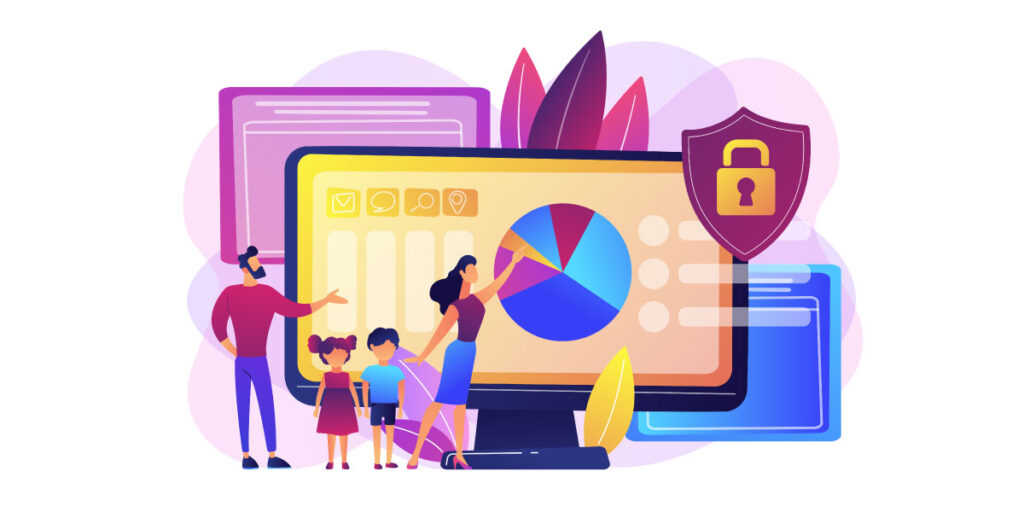If your child doesn’t define themselves as a boy or a girl and doesn’t fit into traditional gender categories, they may have chosen to be non binary. Raising a non binary child comes with various challenges. One of the most pressing concerns for parents today is ensuring their child’s safety online.
Download and Start Your Free Trial of the Safes Parental Control App
The internet is a vast space filled with both opportunities and risks, and it can be especially harmful for non binary children who may face misunderstandings or discrimination. As a parent, you want to protect your child while helping them navigate their identity with confidence. This guide will provide you with non binary parenting tips on how to keep your child safe online and support them through the challenges they may encounter.
Can a Child Identify as Non Binary?
The answer is yes. Children, like adults, can have a strong sense of their gender identity from a young age. Gender identity is all about being male, female, both of them, neither, or something else entirely, and this understanding can develop early in life.
It’s important to listen to and support children when they express their gender identity, even if it doesn’t fit within traditional gender categories. Create an accepting and supportive environment for your non binary child to help them feel validated and confident in who they are, which is essential for their overall development and happiness.
What Are the Signs Your Child Is Non Binary?
Every child expresses themselves differently. It’s important to keep an eye on the signs and listen to them talking about their gender identity. Your child may show some signs of being non binary and express that they don’t belong to any of the male and female categories. Here are some signs to keep in mind:
- Being uncomfortable with societal expectations tied to their assigned gender at birth.
- Rejecting clothing, activities, or behaviors typically associated with boys or girls.
- Preferring to wear neutral or mixed-gender outfits.
- Asking to be referred to by gender-neutral pronouns like “they/them”.
- Choosing a new name that feels more comfortable and aligned with their gender identity, rather than their given name.
- Expressing discomfort or confusion about their body and the changes it’s undergoing, particularly during puberty.
- Showing interest in non binary or gender-diverse characters in media, literature, or real life, and may look up to them as role models.
Watch these behaviors carefully and address their needs with openness and support. As a parent, you should encourage open conversations, and listen to your child’s feelings and experiences, to help them thrive.

What Are The Challenges of a Non Binary Teenager?
In a world full of gender norms and misunderstandings about the gender spectrum, non binary teenagers tend to face unlimited challenges. Supporting them requires getting familiar with these issues and looking for a solution. On the list below, you can see some of the main challenges they might encounter.
Lack of Understanding and Acceptance
- Social Rejection: They may face misunderstanding or rejection from friends, family members, and society.
- Misgendering: Being referred to by incorrect pronouns or names can be hurtful and invalidating.
Mental Health Struggles
- Anxiety and Depression: The stress of not being accepted or understood can lead to mental health issues.
- Identity Confusion: Struggling to find where they fit in can be emotionally taxing.
Bullying and Discrimination
- School Environment: non binary teens might face bullying, harassment, or exclusion at school.
- Public Spaces: Discrimination in public or online spaces is another significant challenge.
Lack of Supportive Resources
- Inadequate Guidance: Many schools and communities lack resources and support systems for non binary teens.
- Medical and Psychological Care: It may be difficult to find knowledgeable and supportive healthcare providers.
Legal and Administrative Barriers
- ID and Documentation: Updating identification documents to reflect their gender identity may be a complicated process.
- Gender-Segregated Facilities: Using gender-segregated spaces like bathrooms and locker rooms tends to be tough for non binary people.
Family Dynamics
- Parental Acceptance: Some teens may not have the acceptance and support from their own families. This will lead to frustration, depression, and mental health issues in them.
- Communication Barriers: Conversations about gender identity are usually difficult and emotionally charged.
Internalized Pressure
- Self-Acceptance: It can be challenging for non binary teens to fully accept themselves in a society that is mainly on a gender binary basis.
- Pressure to Conform: They might feel pressured to conform to traditional gender roles as they may deal with a constant fear of rejection.

How Do You Raise Non Binary Teens?
As mentioned in Authentic Gender Development in Non Binary Children, the environment doesn’t influence children to choose their gender identity. This means that by being around non binary or transgender people, children don’t learn to be one. Their gender identity is something they naturally develop and choose as they explore their world. Therefore, parents need to realize that their children need an environment where they feel safe, supported, and free to express themselves. This can include actively listening to their feelings without judgment, offering unconditional love, and encouraging open conversations about gender.
If you have a non binary teen, you should also educate yourself about gender diversity and get rid of gender stereotypes that society puts in our minds. Moreover, allow them to choose their clothes and hairstyles, support their preferences in toys and activities, and use their chosen name and pronouns. Also, take part in advocating for their rights in school, family gatherings, and society.
How to Keep Your Non Binary Teen Safe Online?
Your non binary teen needs your support and understanding to openly express themselves and feel comfortable within the family. Moreover, while giving them confidence and independence to freely explore the world, you need to always keep an eye on their activities. This is important to keep them away from social threats and harmful experiences, such as bullying, discrimination, and even internet dangers. Your active support appears to be more helpful when it comes to online activities.
Thanks to many parental control tools, you can always control your non binary child’s online experiences and prevent the dangers in the first place. There are various options in your digital devices, such as Macbook parental controls that allow you to monitor what they do in the cyber world. However, these pre-built settings don’t provide you with access to every option you need.
That’s why we’re proud to introduce Safes, our parental control app, that equips you with all the features to make sure your child is safe online. Our goal is to give parents peace of mind knowing that their children, especially those who are nonbinary, are safe exploring the digital world.
Final Word
To support your non binary teen, take time to learn about their identities, recognize the signs, and be aware of the challenges they face. Schools, healthcare providers, and families all play a vital role in this journey to create spaces that respect diverse gender identities.
To ensure your non binary child’s safety online, feel free to get help from Safes. This app helps you monitor and manage your child’s online activities, providing a secure and supportive digital environment. You can download Safes today for Android and iOS, and use our free trial to see how it can help you keep your non binary child safe and supported online.
Your Child’s Online Safety Starts Here
Every parent today needs a solution to manage screen time and keep their child safe online.
Without the right tools, digital risks and excessive screen time can impact children's well-being. Safes helps parents set healthy boundaries, monitor activity, and protect kids from online dangers—all with an easy-to-use app.
Take control of your child’s digital world. Learn more about Safes or download the app to start your free trial today!




